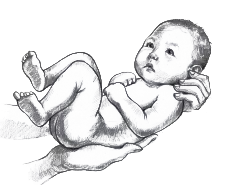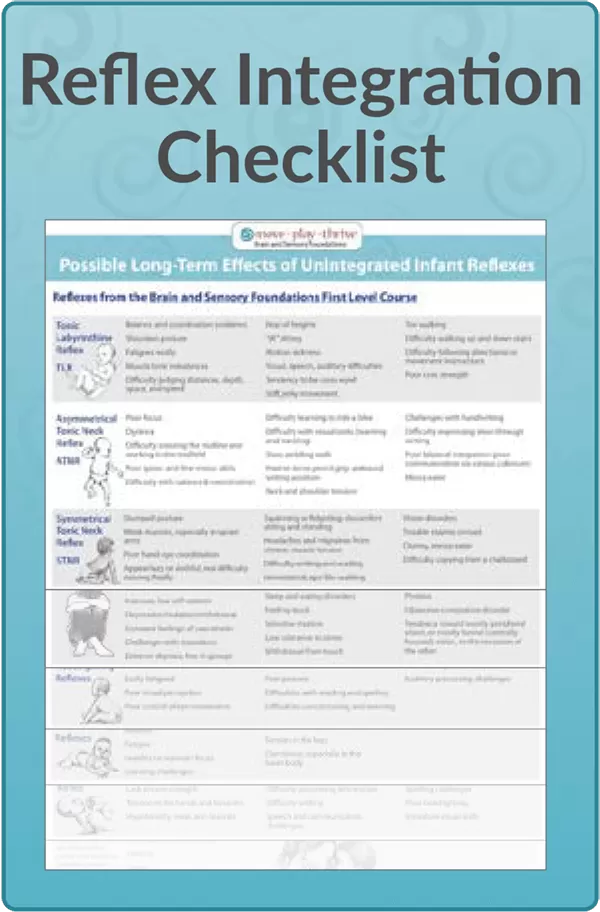Tonic Labyrinthine Reflex
 The Tonic Labyrinthine Reflex (TLR) is vital for addressing issues with core strength, balance, vestibular sensitivity, gravitational insecurity, visual challenges, posture, and stamina. This reflex is activated by movement of the head, and provides the baby with a means of learning about gravity and mastering head control outside the womb. TLR has two positions: flexion (forward) and extension (backward).
The Tonic Labyrinthine Reflex (TLR) is vital for addressing issues with core strength, balance, vestibular sensitivity, gravitational insecurity, visual challenges, posture, and stamina. This reflex is activated by movement of the head, and provides the baby with a means of learning about gravity and mastering head control outside the womb. TLR has two positions: flexion (forward) and extension (backward).
Flexion: As the head bends forward, the whole body—arms, legs, and torso—curl inward in the characteristic fetal position. This position emerges at 12 weeks in utero, and should be integrated by 4 months after birth.
Extension: As the head is bent backward, the whole body—arms, legs, and torso—straighten and extend. This position is present at birth, and is meant to fully integrate by approximately age 3.
The TLR reflex gives the baby opportunities to practice balance, increase muscle tone, and develop the proprioceptive and vestibular senses. Eventually the Tonic Labyrinthine Reflex interacts with other reflexes and bodily processes to help the child develop coordination, posture, and correct head alignment. It is critical for this reflex to integrate because correct alignment of the head with the rest of the body is necessary for balance, visual tracking, auditory processing, and organized muscle tone—all of which are vital to the ability to focus and pay attention.
If normal development is disrupted and the TLR remains active (unintegrated), or if it re-emerges later in life due to trauma or injury, then a variety of physical, sensory, and learning challenges may result.
Possible Long-Term Effects of an Unintegrated Tonic Labyrinthine Reflex:
- Balance and coordination problems
- Shrunken posture
- Fatigues easily
- Muscle tone usually weak or too tight
- Difficulty judging distance, depth, space, and speed
- Fear of heights
- “W” leg position when floor sitting
- Motion sickness
- Visual, speech, or auditory difficulties
- Tendency to be cross-eyed
- Stiff jerky movement
- Toe walking
- Difficulty walking up and down stairs
- Difficulty following directional or movement instructions
- Amphibian Reflex
- Asymmetrical Tonic Neck Reflex
- Birth and Bonding
- Crawling Reflexes
- Crossed Extensor Reflex
- Facial-Oral Reflexes
- Fear Paralysis Reflex
- Feet Reflexes—Plantar & Babkinski
- Foot Tendon Guard
- Hand Reflexes—Grasp, Palmar, and Babkin
- Headrighting Reflexes
- Infant Torticollis
- Landau Reflex
- Moro Reflex
- Parachute Reflex
- Pull-to-Sit Reflex
- Spinal Galant Reflex
- Spinal Perez Reflex
- Symmetrical Tonic Neck Reflex
- Tonic Labyrinthine Reflex
Sources
Accardo, P. J., & Barrow, W. (2015). Toe walking in autism: further observations. Journal of Child Neurology, 30(5), 606-609.
Blomberg, H. (2015). The rhythmic movement method: A revolutionary approach to improved health and well-being. Lulu.com.
Bly, L. (2011). Components of typical and atypical motor development. Neuro-Developmental Treatment Association, Incorporated.
Domingo-Sanz, V. A. (2024). Persistence of primitive reflexes associated with asymmetries in fixation and ocular motility values. Journal of Eye Movement Research, 17(2).
Goddard Blythe, S. (2023). Reflexes, movement, learning & behavior. Analysing and unblocking neuro-motor immaturity. Hawthorn Press.
Goddard Blythe, S. (2014). Neuromotor immaturity in children and adults: The INPP screening test for clinicians and health practitioners. John Wiley & Sons.
Masgutova, S. (2007). Integration of infant dynamic and postural reflex patterns: Neuro-sensory-motor and reflex integration method [Training manual].
Pecuch, A., Gieysztor, E., Wolańska, E., Telenga, M., & Paprocka-Borowicz, M. (2021). Primitive reflex activity in relation to motor skills in healthy preschool children. Brain Sciences, 11(8), 967.
Tabachová, J. M., & Vitásková, K. (2020). Evaluation of primary reflexes in children with communication disorder aged 5 to 10 years in relation to preschool and primary school competences. In ICERI2020 Proceedings (pp. 8171-8178). IATED.
Taylor, M., Chapman, E., & Houghton, S. (2004). Primitive reflexes and attention-deficit/hyperactivity disorder: Developmental origins of classroom dysfunction. International Journal of Special Education, 19(1), 23-37.


